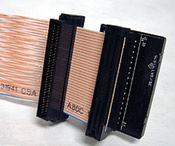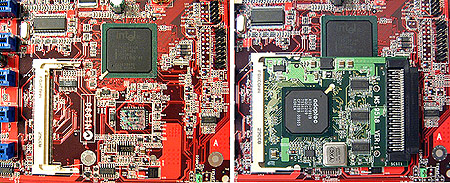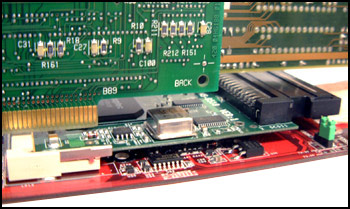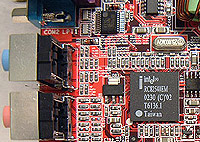
|
The GNB Max is a good board by its own right, but if your computing situation demands more of a heavy-hitter then todays review of the MSI E7205 Master-L could be just what the doctor ordered.
82% Rating: 
|
|
|
|
Home >
Reviews >
Motherboards >
MSI E7205 Master-L |
|
|
What is MiniPCI?
 |
| The MS9518 MiniPCI expansion card
measures 80x60mm and is equipped with a SCSI LVD/SE socket and
Adaptec AIC-7892B SCSI controller. The 32-bit card supports 160M SCSI drives. |
Mini PCI (Peripheral Connect Interface) is an alternate implementation of
the standard 32-bit PCI expansion slots we find on common everyday desktop
mainboards. The Mini PCI slot is essentially a shrunken down version of the
standard 32-bit PCI slot, though there are some differences on the technical level which
are beyond the scale of this review.
At the moment, MiniPCI cards are capped off at 32-bit,
33MHz interfaces, so while there are full-fledged PCI slots that work with 64-bit PCI expansion
cards, that isn't te case with MiniPCI just yet.
 |
| The MiniPCI SCSI 160M card ships with LVD/SE cable and terminator. |
If you own a notebook and have ever
taken off the back cover to install more memory you've probably noticed an adjacent
slot which looks strikingly familiar to the one here. The slots are in
fact identical, and allow notebooks computers a means to expand with devices
like internal 802.11b wireless, or fax/modems based on the MiniPCI standard.
Because
of their small size, MiniPCI cards are the ideal solution for space limited
environments, and on the MSI E7205 Master-L the expansion slot is located
adjacent to the PCI slots where anything larger simply wouldn't fit.
MSI have indicated on their website that
there are currently three possible expansion cards designed specifically for this board. Those include
an ATi RageXL PCI videocard with 8MB on board frame buffer, IEEE1394 and Adaptec Ultra160
SCSI.
There are
many other types of MiniPCI devices ranging from wireless network cards to even soundcards,
but because they are not 'common' PC hardware, expect to do a little searching
if you want to populate this socket with something other than the options MSI
provide.

The benefit of using the SCSI
MiniPCI card is that while the MSI E7205 is a workstation board, there are
only two ultra ATA 100 IDE headers. At two IDE devices per
channel that means you are limited to just four IDE devices (hard drives,
CD-ROMs, ZIP drives, etc.).

As workstation typically get put through the
ringer, SCSI drives have oft been preferred. With the setup here, we have
the option of quickly adding connecting five 160M SCSI hard
drives.
| The Intel RC8254OEM (82544) Gigabit LAN
Controller |
 "The Intel 82544EI and 82544GC
Gigabit Ethernet Controllers are integrated, third-generation,
Ethernet-LAN components, capable of supporting 1000 Mb/s, 100 Mb/s, and 10
Mb/s data rates. These single-chip devices manage both the MAC and PHY
layer functions, and are optimized for LAN on Motherboard (LOM) designs,
enterprise networking, and Internet appliances that use the Peripheral
Component Interconnect (PCI) or PCI-X bus. The controllers provide a
direct 32/64 bit, 33/66 MHz interface to the PCI bus that supports the PCI
Local Bus Specification , as well as the emerging PCI-X extension to the
PCI Local Bus at clock rates up to 133 MHz. The Intel 82544EI and 82544GC
Gigabit Ethernet Controllers provide an interface to the host processors
by using on-chip command and status registers and a shared host-memory
area. The controller's descriptor ring management architecture is
optimized to deliver both high performance and PCI/PCI-X bus efficiency.
Using hardware acceleration, the controllers can offload various tasks
from the host processor, such as TCP/UDP/ IP checksum calculations and TCP
segmentation. The Intel 82544EI and 82544GC Gigabit Ethernet Controllers
cache up to 64 packet descriptors in a single burst for efficient
PCI-bandwidth usage while the large 64KB on-chip packet buffer maintains
superior performance as available PCI bandwidth descriptors change. Fully
integrated physical-layer circuitry provides a standard IEEE 802.3
Ethernet interface for 1000Base-T, 100Base-TX, and 10Base-T applications.
And, with the addition of an appropriate serializer/deserializer (SERDES),
the Intel 82544EI and 82544GC Gigabit Ethernet Controllers alternatively
provide an Ethernet interface for 1000Base-SX or LX applications
(802.3z)." "The Intel 82544EI and 82544GC
Gigabit Ethernet Controllers are integrated, third-generation,
Ethernet-LAN components, capable of supporting 1000 Mb/s, 100 Mb/s, and 10
Mb/s data rates. These single-chip devices manage both the MAC and PHY
layer functions, and are optimized for LAN on Motherboard (LOM) designs,
enterprise networking, and Internet appliances that use the Peripheral
Component Interconnect (PCI) or PCI-X bus. The controllers provide a
direct 32/64 bit, 33/66 MHz interface to the PCI bus that supports the PCI
Local Bus Specification , as well as the emerging PCI-X extension to the
PCI Local Bus at clock rates up to 133 MHz. The Intel 82544EI and 82544GC
Gigabit Ethernet Controllers provide an interface to the host processors
by using on-chip command and status registers and a shared host-memory
area. The controller's descriptor ring management architecture is
optimized to deliver both high performance and PCI/PCI-X bus efficiency.
Using hardware acceleration, the controllers can offload various tasks
from the host processor, such as TCP/UDP/ IP checksum calculations and TCP
segmentation. The Intel 82544EI and 82544GC Gigabit Ethernet Controllers
cache up to 64 packet descriptors in a single burst for efficient
PCI-bandwidth usage while the large 64KB on-chip packet buffer maintains
superior performance as available PCI bandwidth descriptors change. Fully
integrated physical-layer circuitry provides a standard IEEE 802.3
Ethernet interface for 1000Base-T, 100Base-TX, and 10Base-T applications.
And, with the addition of an appropriate serializer/deserializer (SERDES),
the Intel 82544EI and 82544GC Gigabit Ethernet Controllers alternatively
provide an Ethernet interface for 1000Base-SX or LX applications
(802.3z)." |
|
